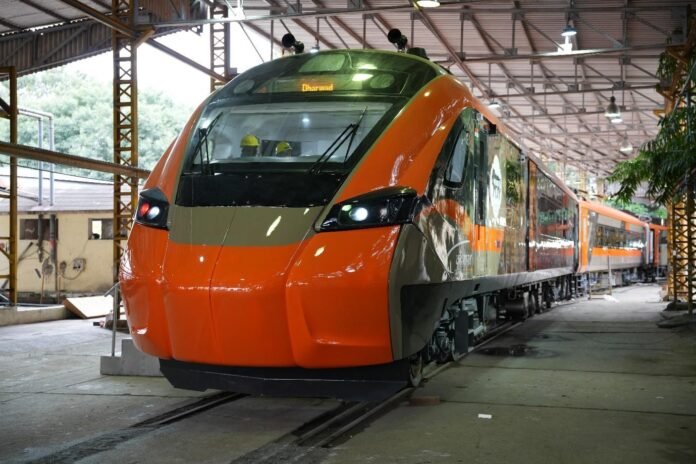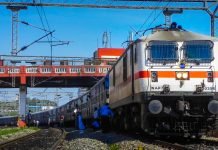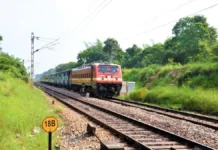India,7th largest and the most populous country in the world necessitates a high level of transport accessibility. The total length of its railway network exceeds 68,000 km, which positions it as the 4th largest Railway network after the US, China, and Russia.
The Indian government has recognised rail transport as a key driver for enhancing passenger and freight mobility. India believes in the creation and expansion of its own facilities and technology transfer with mandatory localisation under the national programme Make in India.
Initiatives to Deploy High-Speed Trains In India
- In 1960, the Railway Board of India initiated a study to increase train speeds, which were then limited to 96 km/h (60 mph) on broad gauge tracks.
- A phased speed improvement plan was set, that aimed to extend train speed to 120 km/h (75 mph) initially and 160 km/h (99 mph) in the long term.
- The Rajdhani Express began operations in 1969 with diesel locomotives, It became India’s first high-speed service, reaching 120 km/h (75 mph).
- The launch of the Shatabdi Express in 1988, powered by WAP-1 electric locomotives, further advanced rail speeds to 130 km/h (81 mph).
Vande Bharat: A Landmark Project Under the Make In India Initiative
Vande Bharat Train formerly known as Train 18 recorded its name in the history of railways by becoming the nation’s first semi-high speed train touching the speed of 180kmph. The thing that made this project unique was the Vande Bharat Train was manufactured indigenously which also outlined the nation’s engineering prowess and self-reliance in the face of modern transportation demands. The success of this project also signified the success of the Make in India initiative
Significance: The Vande Bharat trains were introduced as a modern alternative to the Shatabdi Express. It promised a more efficient and faster travel experience. They were designed to complete the same journey in 15% less time. While these semi-high-speed trains are capable of reaching a maximum speed of 180 km/h, the existing Indian railway tracks are not built to support such high speeds consistently.
Key Factors Behind the Success of Vande Bharat Trains
| Feature | Vande Bharat | Conventional Express Trains |
| Innovative Traction System | Electric traction motors are distributed under alternate coaches, connected to a pantograph drawing power from the overhead electrification system. This allows for superior acceleration and deceleration. | A single locomotive at one end of the train provides power to the entire train. Requires turning around the locomotive at terminals or turnaround points. |
| Power Distribution | Consists of 16 coaches, with 8 motorized coaches providing a total of 12,000 HP. | Power is concentrated in the locomotive, which provides approximately 6,000 HP for the entire train. |
| Speed & Performance | Maximum speed of 160 km/h with the potential for future upgrades. Faster acceleration and deceleration due to distributed power. | Maximum speed of 130-150 km/h with potential upgrades, but typically slower acceleration and deceleration than Vande Bharat. |
| Comfort & Passenger Experience | Features reclining seats, modern interiors, improved suspension, Wi-Fi, air conditioning, and more passenger space for a premium experience. | While comfortable seating is available, conventional trains (e.g., Shatabdi) lack the advanced features, modern design, and passenger-focused amenities found in Vande Bharat. |
Development Phase (2016-2019):
- The project started after foreign proposals for semi-high-speed trains were not successful. The Integral Coach Factory (ICF) in Chennai designed and built the Vande Bharat Trainsets in just 18 months.
- The train was initially named Train 18 and was designed to operate at speeds up to 180 km/h (112 mph) during trials, with a maximum operational speed of 160 km/h (99 mph)
- Train 18 is based on the stainless steel body of Alstom’s LHB passenger cars localised in 2001.
Vande Bharat Train Features
- Cost Efficiency: Priced at $14 million, the new train was 40% cheaper than comparable foreign models.
- Naming and Launch: Originally named Train 18, it was rebranded as Vande Bharat Express and commissioned in February 2019.
- Speed and Performance: During trials, the train achieved a top speed of 183 km/h, making it the fastest in India. However, infrastructure constraints limit its operational speed to 130 km/h.
- Advanced Features: The train’s distributed traction power system provides an acceleration of 0.8 m/s², enabling it to outperform Rajdhani and Shatabdi Express trains at 130 km/h, despite the lower top speed.
Vande Bharat 1.0 Production
- Only two Vande Bharat 1.0 trains were produced between 2019 and 2022.
Vande Bharat 2.0:
To unleash the potential of the Vande Bharat Train Series, Indian Railways took a step forward and launched the new avatar of Vande Bharat: Vande Bharat 2.0. The second-generation Vande Bharat train was developed and tested amidst the COVID-19 pandemic. On 21 January 2021, M/s Medha Servo Drives Ltd. received an order of Rs 2211 crore from the railways to manufacture 44 Vande Bharat trains having 16 coaches. Prime Minister Shri Narendra Modi flagged off the first trainset of the Vande Bharat 2.0 version on September 30, 2022, from Gandhinagar to Mumbai.
This upgraded version was equipped with a range of advanced features over its predecessor. With the new upgrade, Vande Bharat Train could achieve a speed of up to 180 km. It was also lighter, weighing 392 tons instead of the earlier 430 tons.
The Key Features of Vande Bharat 2.0
Improvised Safety
Passenger safety has been a top priority for Indian Railways. The new generation Vande Bharat Trainsets were equipped with indigenously developed Automatic Train Protection System Kavach (Train Collision Avoidance System).
Additional Safety System
| Emergency Windows | 4 emergency windows were added in every coach for improved security. |
| Cameras | 4 platform-side cameras, including rear-view cameras outside the coach (earlier, there were only two). |
| Safety Certification | New coaches have Level-II safety integration certification for better train control. |
| Fire Safety | Improved fire safety with an aerosol-based fire detection and suppression system in all electrical cubicles and toilets. |
| Floodproofing | Superior floodproofing for under-slung electrical equipment, now capable of withstanding floods up to 650 mm (earlier 400 mm). |
| Emergency Lighting | 4 emergency lighting units in every coach for backup during electrical failures. |
Enhanced Passenger Amenities
Indian Railways extended its expertise from safety to providing a better travel experience to passengers. This includes
| Feature | Details |
| Riding Comfort | Enhanced riding comfort with a 3.5 riding index. |
| LCD TVs | 32-inch LCD TVs replacing the earlier 24-inch TVs. |
| Passenger Information System | Equipped with a Passenger Information and Communication System. |
| Energy-Efficient ACs | 15% more energy-efficient ACs with dust-free clean air cooling of the traction motor for a more comfortable journey. |
| Rotating Seats in Executive Class | 180-degree rotating seats for Executive Coaches. |
| Bio Vacuum Toilets | Equipped with touch-free amenities for better hygiene. |
Other Advancements
Previously, the Vande Bharat Train used to take 145 seconds to reach the speed of 160 kmph. However, the Vande Bharat 2.0 version was capable of reaching the speed in just 140 seconds. It also included other upgrades such as:
| Feature | Details |
| Advanced HVAC System | Equipped with a high-efficiency compressor and an Ultra Violet (UV) lamp for a germ-free air supply. |
| Formation Change | It Includes a non-driving trailer coach in the middle for improved acceleration and deceleration. |
| Signal Exchange Lights | Two signal exchange lights on the coaches for communication with way-side stations. |
Vande Bharat 3.0: A Benchmark for Safety, Speed, Comfort & Efficiency

The third generation of the Vande Bharat Train Series is a new addition to the Indian Railways fleet. The Vande Bharat 3.0 model is designed for long-distance travel and features sleeper coaches. This train has 16 coaches: 11 AC 3-tier, 4 AC 2-tier, and 1 AC First Class coach. The Vande Bharat Sleeper train can carry up to 823 passengers.
BEML Rolls Out First Vande Bharat Sleeper
On 1 September 2024, Hon’ble Union Minister for Railways, Shri Ashwini Vaishnaw flagged off India’s first Vande Bharat Sleeper trainset at BEML’s Bangalore rail complex. Indian Government plans to deploy 200 Vande Bharat 3.0 by 2029. BEML formerly known as Bharat Earth Movers Limited, has been a great contributor to Indian Railways. The company has produced and supplied over 18,000 mainline passenger coaches of various types for the Indian Railways. On 23 May 2023, BEML bagged a contract worth Rs 675 crore from Indian Railways’ Integral Coach Factory (ICF) to produce India’s first 10 Vande Bharat sleeper trainsets.
Vande Bharat Sleeper Train Achieves 180 km/h in Speed Trials
The Vande Bharat Sleeper Train successfully achieved a peak speed of 180 km/h during multiple trial runs conducted between December 31, 2024, and January 2, 2025. The trials were conducted with the train in a fully loaded condition to assess its performance and stability at high speeds.
Key Trial Runs and Achievements
- December 31, 2024 – January 2, 2025:
- Kota – Laban (30 km run): 180 km/h achieved on January 2.
- Rohal Khurd – Kota (40 km run): 180 km/h achieved on January 1.
- Kota – Nagda section: The train reached 170 km/h.
- Rohal Khurd – Chau Mahla section: A peak speed of 160 km/h was recorded during the run.
Key Features of Vande Bharat Sleeper Train
The Vande Bharat Sleeper Train has been designed to enhance the overall travel experience while also considering the comfort of onboard staff and train operators. The key features include:
1. Passenger Comfort & Amenities
- Improved Air Conditioning – The train is equipped with an upgraded air conditioning system that allows better temperature control.
- Oxygen Level Maintenance System – This feature helps maintain appropriate air quality inside the coaches.
- Redesigned Toilets – The train includes modernized toilets with improved accessibility and hygiene.
- New-Generation Seating – Sleeper berths and seating areas have been upgraded with improved cushioning and high-quality materials for better comfort during long journeys.
2. Facilities for Train Staff and Driver
- Dedicated Cabins for Loco Pilots – The driving cabins have been designed to improve ease of operation and ergonomics for loco pilots, who spend long hours on duty.
- Toilets for Drivers – To ensure convenience, separate restroom facilities have been incorporated for train operators.
3. Safety & Operational Enhancements
Advanced Safety Measures – The train is integrated with updated fire safety systems and other protective features to ensure passenger security.
Major Contract Released By Indian Railways for the Production of Vande Bharat 3.0
| Version | Manufacturer / JV | Contract Details | No. of Train Sets / Coaches | Manufacturing Location(s) |
| Vande Bharat Sleeper Version | TMH-RVNL JV (Transmashholding-RVNL) | ₹35,000 crore-36,000 crore contract + 35 years maintenance | 120 train sets | Latur (Maharashtra) + Other locations |
| Vande Bharar Sleeper | BHEL-Titagarh | Rs 9,600 crore contract + 35 years maintenance | 80 Trainsets | |
| Vande Bharar Sleeper | BEML | Rs 675 crore | 10 Trainsets | BEML, Bangalore |
| Aluminium-Bodied Vande Bharat (Canceled) | Alstom (France) | Indian Railways cancelled ₹30,000 crore tender for 100 lightweight train sets due to high pricing | 100 train sets (planned) | N/A (Contract Canceled) |
Revision in contracts
The Indian Railways has proposed a change in the contracts worth Rs 58,000 crore for 200 Vande Bharat sleeper trains. Now, each train will have 24 coaches instead of 16, but the total number of trains has been reduced from 200 to 133.
Contract for 120 Vande Bharat
In March 2023, Rail Vikas Nigam Ltd (RVNL) and Russia’s CJSC Transmashholding (TMH) secured a contract to manufacture Vande Bharat Sleeper Trains. The joint venture will now supply 80 Vande Bharat Trains instead of 120. Each train will have 24 coaches instead of the original 16.
Contract for 80 Vande Bharat
Bharat Heavy Electricals Ltd (BHEL) and Titagarh Wagons had been awarded a contract to supply 80 trains. The price for each train is set at Rs 120 crore, resulting in a total contract value of Rs 9,600 crore. This consortium will now supply 53 trains instead of 80.
Vande Bharat: A Dawn of New Age Rail Transportation
- Vision for 4500 Vande Bharat: Indian Railways is planning to deploy 4500 Vande Bharat Trains by 2047 across its vast network. Currently, 136 Vande Bharat trains are operational across the country on medium & short distances.
- Increasing Foreign Interest: The Vande Bharat train is gaining interest from buyers in other countries. Chile, Canada, and Malaysia want to import it because it is cost-effective. Trains with similar features from other countries cost between Rs 160 to 180 crores, while India produces the Vande Bharat for only Rs 120 to 130 crores.
- Vande Bharat Operations on High-Speed Rail Corridor: India’s first high-speed rail project will connect Mumbai and Ahmedabad with bullet trains. Because of delays with the Japanese Shinkansen system, Vande Bharat trains will initially operate on this corridor. However, the Railway Ministry recently asked for bids for a European signalling system that works with Vande Bharat trains, which shows a change in strategy.
Conclusion
The Vande Bharat Train project is a key achievement under the Make in India initiative. It demonstrates India’s capabilities in indigenous train manufacturing. As the nation progresses toward its goal of becoming a developed economy by 2047, these trains are setting benchmarks for the future of rail transportation. The Vande Bharat trains are making urban and semi-urban areas more accessible By linking cities with faster and more comfortable rail services.
This has attracted businesses and investment to the regions that fall within the catchment area of Vande Bharat routes. The improved connectivity is also benefiting the tourism sector, as it is generating employment opportunities in related industries. As more routes are introduced, the trains will continue to strengthen India’s transportation infrastructure, support economic activity, and contribute to the country’s long-term development goals.






